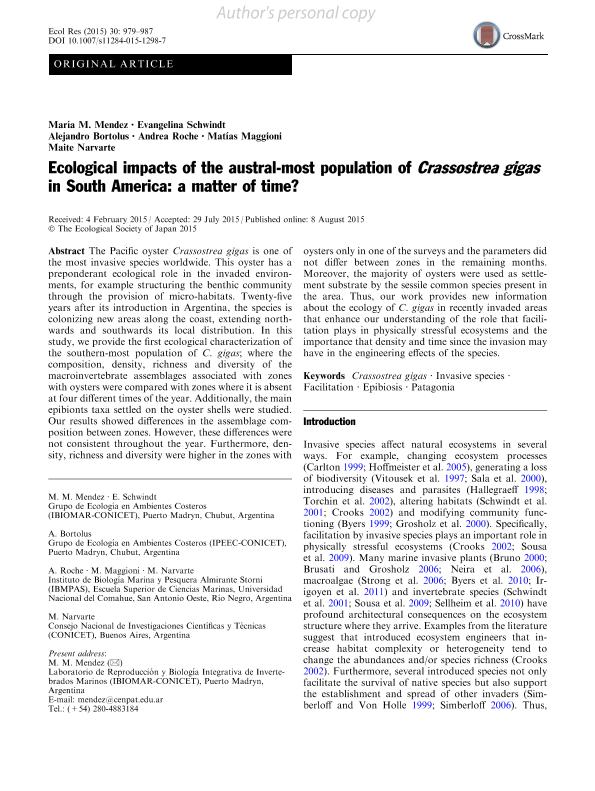Artículo
Ecological impacts of the austral-most population of Crassostrea gigas in South America: a matter of time?
Mendez, María Martha ; Schwindt, Evangelina
; Schwindt, Evangelina ; Bortolus, Alejandro
; Bortolus, Alejandro ; Roche, Andrea; Maggioni, Matías; Narvarte, Maite Andrea
; Roche, Andrea; Maggioni, Matías; Narvarte, Maite Andrea
 ; Schwindt, Evangelina
; Schwindt, Evangelina ; Bortolus, Alejandro
; Bortolus, Alejandro ; Roche, Andrea; Maggioni, Matías; Narvarte, Maite Andrea
; Roche, Andrea; Maggioni, Matías; Narvarte, Maite Andrea
Fecha de publicación:
11/2015
Editorial:
Springer Tokyo
Revista:
Ecological Research
ISSN:
0912-3814
Idioma:
Inglés
Tipo de recurso:
Artículo publicado
Clasificación temática:
Resumen
The Pacific oyster Crassostrea gigas is one of the most invasive species worldwide. This oyster has a preponderant ecological role in the invaded environments, for example structuring the benthic community through the provision of micro-habitats. Twenty-five years after its introduction in Argentina, the species is colonizing new areas along the coast, extending northwards and southwards its local distribution. In this study, we provide the first ecological characterization of the southern-most population of C. gigas; where the composition, density, richness and diversity of the macroinvertebrate assemblages associated with zones with oysters were compared with zones where it is absent at four different times of the year. Additionally, the main epibionts taxa settled on the oyster shells were studied. Our results showed differences in the assemblage composition between zones. However, these differences were not consistent throughout the year. Furthermore, density, richness and diversity were higher in the zones with oysters only in one of the surveys and the parameters did not differ between zones in the remaining months. Moreover, the majority of oysters were used as settlement substrate by the sessile common species present in the area. Thus, our work provides new information about the ecology of C. gigas in recently invaded areas that enhance our understanding of the role that facilitation plays in physically stressful ecosystems and the importance that density and time since the invasion may have in the engineering effects of the species.
Palabras clave:
Crassostrea Gigas
,
Epibiosis
,
Facilitation
,
Invasive Species
,
Patagonia
Archivos asociados
Licencia
Identificadores
Colecciones
Articulos(CCT - PATAGONIA NORTE)
Articulos de CTRO.CIENTIFICO TECNOL.CONICET - PATAGONIA NORTE
Articulos de CTRO.CIENTIFICO TECNOL.CONICET - PATAGONIA NORTE
Articulos(IBIOMAR)
Articulos de INSTITUTO DE BIOLOGIA DE ORGANISMOS MARINOS
Articulos de INSTITUTO DE BIOLOGIA DE ORGANISMOS MARINOS
Citación
Mendez, María Martha; Schwindt, Evangelina; Bortolus, Alejandro; Roche, Andrea; Maggioni, Matías; et al.; Ecological impacts of the austral-most population of Crassostrea gigas in South America: a matter of time?; Springer Tokyo; Ecological Research; 30; 6; 11-2015; 979-987
Compartir
Altmétricas



